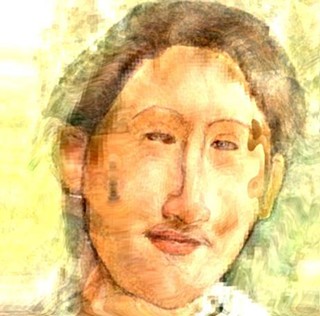Oh, forget it. Let's just take each show individually.
Seeing Arizona Theatre Company's febrile production of Shakespeare's Macbeth is in some ways like watching a current Hollywood movie, and not just because it employs a lot of video work. Like many of his artful Hollywood colleagues, director Stephen Wrentmore has spent a great deal of time working on a fabulous production design and devising some elaborate and on-the-mark subtexts. But when it comes to line readings, he seems to have left the actors to their own devices. Some of the delivery is curiously flat, particularly compared to the energy and intensity of Celeste Ciulla as Lady Macbeth.
Wrentmore has moved the action from Medieval Scotland to a proto-fascist European state in 1935. He has stripped out what little comic relief Shakespeare provided for this bloody tragedy (only a few shreds of the Porter's scene remain) and has made the power-grabbing Macbeth the pawn not only of his ambitious wife, but of the three witches who are usually employed merely to prophesy Macbeth's rise and doom. The witches are a constant presence, disguising themselves as minor figures in the action (including compliant members of the press) and managing Macbeth's every misstep. Reassigning some minor figure's lines to a witch can give even the most innocent statement a sinister twist, and Wrentmore handles this beautifully.
The action plays out on a simple but apt set designed by Scott Weldin. Panes of shattered glass hung just below the proscenium over three constructions of large, woven and tangled strips of metal. On the overhead glass, and at one point on a movie screen on stage, are occasional projections of full newsreels (scenes of Macbeth and his wife intercut with historical footage of unspecific fascist rallies) and single images, like close-ups nobody is meant to see (Lady Macbeth leaves a red lipstick mark on the cheek of the soon-to-be murdered king).
Wrentmore has also introduced into the play the ghost of Macbeth's dead child, something Shakespeare did not specify. It's an interesting concept, but it doesn't quite work, simply because Wrentmore doesn't develop it sufficiently.
Most of this, plus Roberta Carlson's disturbing score--some of her best work to date--all makes for compelling theater, every touch (even the underused dead boy) truly relevant to Shakespeare's text and illuminating the characters' motivations.
There's far less unity to be found, though, in the acting. The best and most consistent work comes from the relatively few women in the large cast, from Ciulla's Lady Macbeth at the top through the trio of witches down to Harris Kendall in her single brief scene as Lady Macduff.
Ciulla slinks onto the stage in costume designer David Kay Mickelsen's sexy variations on red-splattered-on-black, initially giddy with ambition. Gradually, as Lady Macbeth stage-manages the king's murder and later becomes haunted by her complicity in the act, Ciulla's giddiness becomes high-strung, then a bit shrill, finally settling into somnambulistic madness. Ciulla, lithe and vibrant, follows a clear trajectory for her character.
Deborah Fialkow, Christen Simon and Maren Maclean as the "weird sisters" provide a consistent atmosphere of carefully gauged malevolence, avoiding Halloween witchiness except, perhaps, in the cauldron scene (here the evil potion is replaced by photographic chemicals in a darkroom). Harris Kendall, a local actress, is, as usual, low-key but intensely focused and utterly natural as the ill-fated Lady Macduff.
Few of the men seem this at-home in their roles or in the language, except for some of the bit players, notably Roberto Guajardo and Nat Cassidy. As Macbeth, Matt Loney ends well, finally stepping into the character as Macbeth loses his mind (for in Wrentmore's conception, the title character's collapse occurs before his military defeat, as it logically should). But initially his performance is unmodulated and bland; he seems more like a corporate vice president jockeying to become CEO.
In the last third of the play, the actor who makes the most remarkable impression is Richard Trujillo as Macduff. He's fully into his character, even when there's little for him to do, and the scene in which Macduff is informed of his family's murder should bring you to tears through its lack of histrionics and its long, painful moments of silence.
This is certainly a production of Macbeth that's worth seeing and marveling at, but I'd suggest you wait until late in the run, when the actors have had more time to grow into their roles.
The most bizarre aspect of The Rocky Horror Show at the University of Arizona is not the colorfully flouncy-seedy Hydra-reject costume design by Patrick Holt, nor is it the concept of an innocent couple stumbling upon an enclave of transvestites from outer space, nor is it the spectacle of male students dressing up in fishnet stockings and bustiers and, at one point, simulating anal sex for college credit.
No, what's really bizarre about Arizona Repertory Theatre's production of Rocky Horror is that, although returning to the cult phenomenon's roots as a stage show, it has swept up and institutionalized some of the audience-participation shtick that has become customary at midnight screenings of the movie version.
Director Richard T. Hanson has planted a couple of shills in the audience, and on a few occasions even had members of the cast shout out the sassy backtalk lines that you'd hear at the Loft every weekend. When, for example, the ridiculously naïve hero, Brad, speculates that the strange castle he and his fiancée, Janet, have stumbled into is a "hunting lodge for rich weirdos," a heckler shouts, "Rich weirdos aren't in season, asshole!"
Indeed, the audience receives some coaching before the house lights dim; cast members train them to shout "asshole!" at the mention of Brad's name, and "slut!" when Janet's name is uttered. There's also the obligatory participation kit on sale outside the theater, containing such handy items as a newspaper, playing cards and toilet paper.
On opening night, though, the honest-to-goodness audience members seemed disinclined to participate; they preferred to sit back and wallow in the joyful bad taste of it all.
The Rocky Horror Show, concocted by Richard O'Brien in the 1970s after a misspent childhood watching only the most ridiculous science-fiction and horror movies, is intentionally bad art, but it's also great fun. As you are no doubt aware, the show's plot, such as it is, finds the innocent Brad and Janet wandering into a castle occupied by the salacious associates of Frank-N-Furter, a "sweet transvestite" from planet Transsexual in the galaxy Transylvania. Frank and friends seem to be up to no good--this is pretty obvious when Frank takes a chainsaw to his discarded boy toy--but the precise nature of the group's mission on Earth is never quite clear. All semblance of narrative logic falls apart in the second act, as does O'Brien's inspiration, and the lusty cast can't quite save the show from its own creator.
What Frank has created, though, is a studly plaything for himself. He also creates mayhem when it comes to the sexual identities of Brad and Janet, and before long, Frank is no longer the one on top.
This is a high-energy ensemble show, but the whole thing really revolves around Frank. Luckily for us, the character struts and sneers into life in the befeathered form of David Olsen, a wonderfully talented entertainer who would be unrecognizable when not in high heels or robes. (He played Sylvia St. Croix, talent agent from hell, in Ruthless! three months ago, and he was a surprisingly nuanced Polonius in Hamlet a year ago.) What's most remarkable about Olsen's sexy-campy performance is that it never makes us think of Tim Curry, who played Frank to the hilt in the movie version and original stage production. (Curry's face does pop up on a cast member's T-shirt.) If Olsen lacks Curry's subtle menace, he has an ironic verve all his own.
Joey Topmiller and Molly Rice are clearly having fun as the befuddled Brad and Janet; Ben Crawford glowers gloriously as the servant Riff-Raff; Sarah Spigelman and Jessica Dorman are lively and slutty as minions Magenta and Columbia; Luke Bishop is endearingly surfer-dudish as Rocky (Frank's science project); Andrew Goldwasser makes the most of his double role (the ill-fated rock maven Eddie and the Strangelovish Dr. Scott); and Brian Hendricks is a low-key hoot as the professorial, portentously pausing narrator.
The assorted (or is that sordid?) Phantoms and the backstage band led by Elizabeth Spencer also turn in appropriately sleazy work, and Joel Young provides a lighting design worthy of a Van Halen concert. Actually, he's done the lighting for Van Halen concerts.
The one aspect of the production that's dissatisfying is director Hanson's decision to get serious at the end with a little slide show of atrocities. The whole point of Rocky Horror is that it has no redeeming social value, and trying to impose some at the last minute is a mistake.
After all, as Frank-N-Furter says, there's no crime in giving yourself over to pleasure.
The Catalina Players, a community theater troupe, is doing some of its smoothest work in The Nerd, a comedy by Larry Shue. Young architect Willum Cubbert (Joshua Walker) is stuck working on a demeaning hotel project, and about to bid farewell to his girlfriend, Tansy McGinnis (Heather Miel), who's taking a big job out of town, partly because Willum lacks what she calls "gumption." Willum's pal Axel Hammond (Charles Prokopp), being a curmudgeonly theater critic, seems content to stand by and do little more than make snide comments as the action plays out.
At this delicate point enters Rick Steadman (Don Poage), who saved Willum's life in Vietnam (Willum was unconscious at the time) and to whom Willum owes much. Alas, Rick is the nerd of the title, an insufferably thick-headed and childish fellow who is the very definition of "socially inappropriate." Rick comes to stay, and stay, and stay, and eventually the three friends must go to farcical lengths to get rid of him.
Directed by Leslie J. Miller, the cast maintains a good pace and ensemble feeling. Best of all is the over-the-top Poage as nerdy Rick, with Prokopp also especially effective as the ironic-to-the-core Axel. Pat Shafer, Amy Gallegos and particularly the exasperated Steven M. Adelson also turn in good work.











